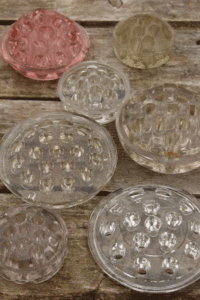
Flower frogs are devices that are used to help arrange flowers quickly and conveniently. They are collected for their unique look, utilitarian purposes and history.
You might have seen a strange glass object in an antique store or florist shop that you can’t identify.
It was glass, round, and had a bunch of holes in it, much like a honeycomb.
This is called a flower frog, and is a device utilized to help arrange flowers quickly and conveniently.
They are collected for their unique look, utilitarian purposes and history.
It is thought the term “frog” came from the fact that the holder sits in water like a frog.
The first flower frogs, also known as flower bricks, squares or blocks, were Japanese — and were called kenzan, which were metal and fixed in a bowl or vase to hold the stems of flowers for quick arranging.
The Japanese were and are well known for Ikebana, or “making flowers come alive” with simplistic, orderly designs in the floral arranging world, and the frog certainly would have aided the quest for proper arranging.
The general idea of a flower frog is that the myriad of holes in the often round piece of glass or metal is for the stem of a flower to poke into, thus helping you arrange a bouquet quicker and with ease.
Other versions of the frog were invented, such as cages and pin holders.
This type of florist aid has been around for a long time, with some dating back to 16th century Europe.
The oldest U.S. patent for a frog was issued in 1875 by S. Van Stone Company, which created a cone flower holder, that was placed on a stand.
This company also created a mushroom shaped frog that held flowers and other items.
Many well known pottery and glass houses obtained patents and manufactured this item.
The Cambridge Glass Company, a well known U.S. glass manufacturer, obtained a round glass frog patent in 1916, and collectors can look for the word “Cambridge” embossed on the side when collecting them for authenticity.
Frogs come in many different materials besides just glass. Metal, plastic and glass are the most popular materials used to make this floral implement.
Dazey Manufacturing patented the first metal flower frog “cage” in 1916, a small device that held flower stems in a sort of cage creation, rather than holes.
It allowed for more complex displays.
There is also a version of this metal creation called the “pin” frog, created by many companies, that allowed stems to be stuck onto a pin, rather than inside a hole.
The flower frog saw its heyday in the 1920s, in the flapper era, before the great depression, in a time when fresh flower arranging inside a home, in grand mansions and during balls was all the rage.
To have a tool that would help arranging came in handy.
Today they are collected for their unique history, odd appearance and manufacturing wonder.
Many are still used today to create beautiful arrangements, like so long ago, people still enjoy a beautiful, easy arrangement of gorgeous flowers.
(Editor’s note: DeeDee Wood is the owner of Black Cat Curiosities Art and Antiques in Easton, Md., located at 24B Harrison St.)



